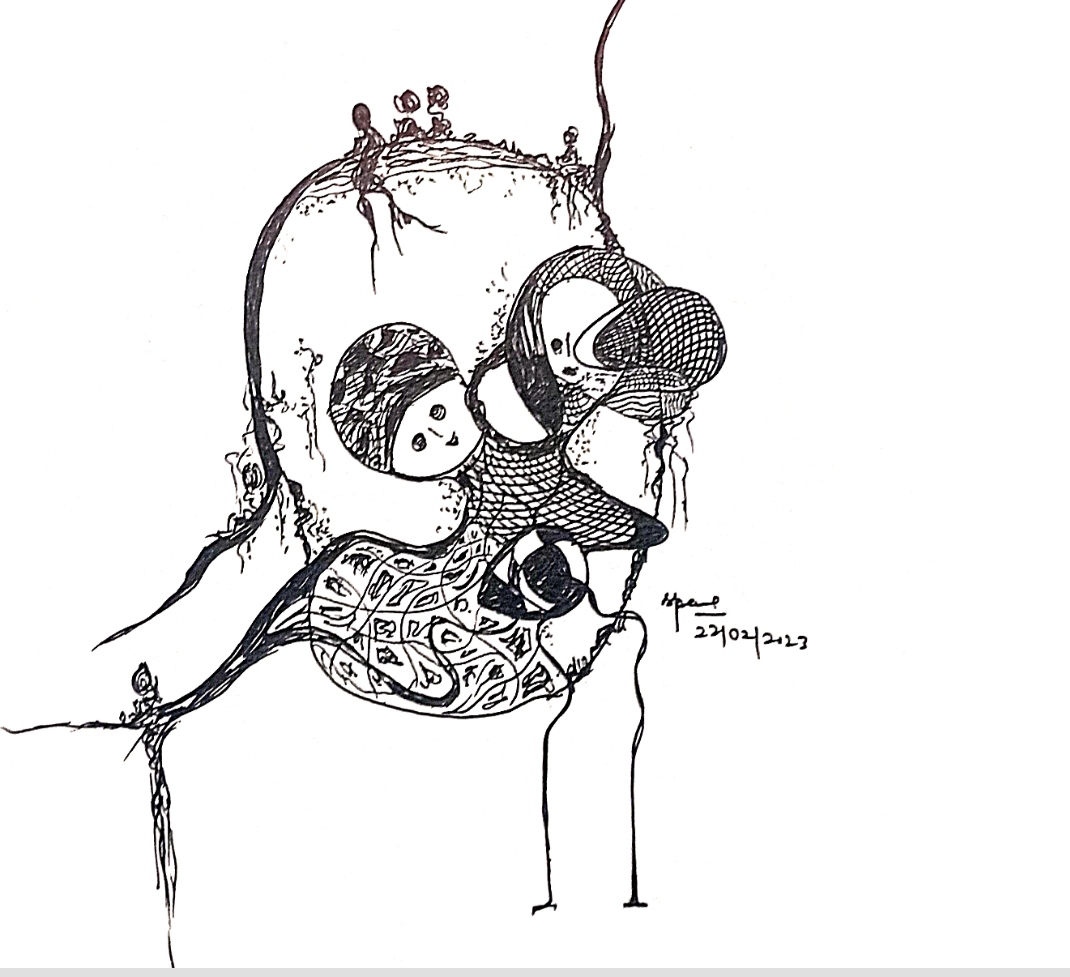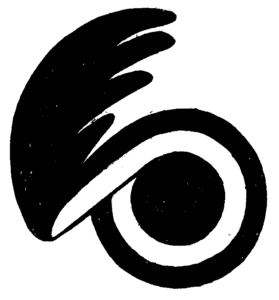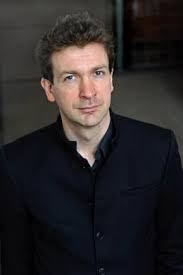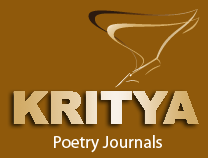
Editor’s Choice
ERIK LINDNER
Translated by Paul Vincent
To Acedia
1.
She is where she saw him.
(A sideways glance
at the opposite lane.)
The case by his right foot.
A coat over the arm.
He asks: was her hand ever here?
He sits down on the upright case.
A hand burns on her abdomen
and a hand burns above
the revolving car tyre in the sun.
She wipes spittle from her lips.
She brushes sunlight from his suit.
2.
When on her knee a filter cigarette
sticks into the opening of a matchbox,
she sticks a hand into her sweater’s V-neck.
Her fingertips on the collarbone.
A pin on his suit. (Milk from the searchlight.)
Socks with fine stripes in. Thumb edge under a brooch.
A smile in a hankie kneaded to a yawn.
Nothing escapes her.
No one escapes her.
A tea towel with no motif.
A loaf with no oven.
3.
I think those birds are just right for a boat trip like this
she says and on the railing
her hand masks the graffiti.
She has a dress round her neck.
The make-up’s the day before’s.
A gust of wind and her ear lobe’s released.
His mouth seldom tastes
of the bunk in the hull.
Birds are tapping against the frame.
The tramontana
Off the coast the diver rests in his story
and sparsely draws the cliff behind the beach.
The wind cuts the story and wears and rubs
the leaves from off the plane trees – the window frame.
I had the wind behind me for this story.
The journey narrated a man walked over the mountain
and the tale gets bogged down in the sea. The wind
lords it over his grave. And the diver is trapped
among the stones, the helpers pop
up and the wind crushes the swell and the sea.
The diver’s painting wind gusts off the coast.
The cliff’s in bloom. And the grave is a step
to the coral in a cavern on the bottom
above the colour engraving of the flower curtain.
*
There is blood in your lips
and yet the wind pipes
yet the tube rumbles
under the table so much
that your head slumps
and even a faint word
explodes in your ear
your hair is strewn
across the cloth
yet your eye opens
and weighs in the lamplight
the dust that vibrates in the air
and the stuff that descends on you
too small for the table
too fine for the wind.
Ourcq
From the ice-breaker clearing the quay
cracks dart though the layer of ice,
from one bank across to the other
the ship trembles the ice breaks up,
the surface tilts deep into the canal
and bulges and splits, crumbles and melts.
Now one can see
how heavy a swan must be.
Tough as its belly and webbed feet
Is the ice, not white but transparent.
Where it stands is a layer of water.
Someone scoops the ice from the fountain.
Someone stacks tiles in a crate.
Someone raises the bridge.
The ice-breaker approaches.
The swan stares without pause.
Ostend
1. A bone lies in the sand
of an island that doesn’t stand still
the form is fixed
the history of the wind
the thrust of marrow and stone
the wind gets lost at sea
no wave has the same dimensions
sand colours red in the sun
on the race track where dust blows up
and the hooves the same rhythms pound
the hooves sand to fragments pound
across an island the wind roams
and reworks its previous prints
the marrow stone of the beach,
the race track on the coast
the rain in the sea.
2.
The sea is the size of the wind
and overflows onto the marrow stone
worked by the wind for the sea
stones are invisible to the sea
a sandpiper walks past the wind
and with its steps counts
the loose particles of sand
and the tops of the waves blown off
and the flakes of the wind flown off
rolling creeping shifting pieces
of an island still for a moment
on the edge of the sea
the sand thrusts the marrow
hooves crush the stones
the sea bears the bone to the shore
the sand cools off in the wind
flakes measure the size
of a temporary island created
beneath the steps of the sandpiper
outside the wind
above the sea
*
A tree grows through the foliage
a door stands open above water
moss in a strip along the eaves
a greenhouse half lit
the roof of the lift has slid out of place
plaster falls through the shaft
between the factory and the street lamps stretch cables
cables run straight to the mast
on the bridge a hose sprays
traffic slows down and waits
that dog drags a lead along the ground
that cyclist pushes her skirt against her thigh
this piece of the paper blows round a branch.
*
The push-off with which a sponge wipes
the glass table in the library
the creaking of the steel gate sounds
a ship chafing the quay
seagulls around the square on the hill
a shutter opens halfway down the street
I get up and dress for yesterday
and walk along planks to the ferry
on car tyres coral stands out
in scales between jetty and bow
but my nails grow my callus
each water drop a contact lens
stares a season in quarantine
at how a door slams over the railing
the window beckons and the light paints
the chamois that’s taut on your skin.
*
The window opens a crack
and the table to here
breaks
at once
and the table’s not by the window
but has moved next to me here
at the foot of the table
the cloth falls off the table
in the light of the window
the leaf bends an arm’s length
a bar breaks at the elbow
in the drawer: crumbs paperclips
the cardboard wedge that keeps the table
straight and the window open
a shifting square over the table
touches the ground in one piece.
4. All that is not born can also disappear.
Sand, roots, helm grass, tracks that never
ran here. The inhabitants who gaze after
the traveller but do not give his description.
Their gait still disturbed after the building
of a monument. Now, as the tramontana
licks at your body and picks up you and your glasses,
carries them along. Where the passage brings
the churchyard to the edge of the abyss above the surf.
Details of it only the short-sighted can find.
How it got here? Fifty years ago. To for-
get such a thing is barbaric. Even the defacing
of an artwork is a cultural expression.
I did this. Unscrupulous. Today. Date.
Klockmann
If there were a god he would have made you
ground your belly into which he blows air
with mouth and bellows stemmed your bleeding
and slid you tethered to a belt or chain
to a cool place in the oven
the knight is the only chess piece with eyes
its manes are straight as bones and fins
its muzzle reaches for the bishop’s groove
the king’s cross the rook and pawn
the ball on the queen’s hat
but god becomes land consolidation macaroons
or anodized the ten-cent coin the sea stars
step up the fair the wheel of the watermill
not quite underwater the whiskers of an otter
jewels of a human being bathing and drying.
Notes:
‘Ostend’ is written with the silent movement Images d’Ostende (1929) from Henry Storck, for “35mm poem’ at the first biennale of the Filmmuseum in Amsterdam, 2003.
’18 september 1994′ is written at the monument from Dani Karavan for Walter Benjamin, who died in 1940 in Port Bou.
‘Klockmann’ is written for an exhibition of the jewellery of Beate Klockmann in Galerie Marzee in Nijmegen, 2006, courtesy of literary festival De Wintertuin.
ERIK LINDNER
Erik Lindner (born 1968) is a poet that is born in The Netherlands. He made his debute with Tramontane (1996) and published two books of poetry since: Tong en trede (Tongue and step, 2000) and Tafel (Table, 2004). In french translation a book was published in 2007: Terrain (Centre Internionale de Poésie Marseille / Spectres Familiaires, 2007). Erik Lindner lives in Amsterdam and works as a freelance literary critic.
“Erik Lindner made his debut in 1996 with Tramontane, a collection of poems without literary predecessors: Lindner did not join any group or movement. If there would seem to be any exterior influences in his work, these could best be described as ‘accidental passers-by’ – writers and philosophers who happened to cross the poet’s path. In Tramontane one such passer-by is Walter Benjamin, whose motto ‘Man’s gaze is his edge” seems to offer a key to Lindner’s poetry.
In his poems, the edge of man’s gaze is the town, a room, or a landscape. Lindner tries to capture the casually perceived movements in language. His poetry is pervaded by the idea that the word creates a coherence. The idea is found again in Tong en trede (Tongue and step, 2000), a collection which, as poet Jan Baeke put it, evokes a reality “which in its seeming triviality brings to light all sorts of wonderful, intangible facets”. This seeming triviality is primarily to be found in Lindner’s images, although ‘observations’ might be a better word: he is a permanent wanderer, a passer-by, who carefully registers the tiny movements of life in a city or the apparent stillness in a room. “So a passer-by explains what passing is:/ a town you leave while you are staying there”, he writes in the opening poem of the cycle ‘Temporary stop’.
In Lindner’s poetry each sentence seems to contain a new registration, and the ‘rapid’ succession of the observations suggests something like the continuous movement in reality, the chaos, or, in other words, the simultaneity of all those movements. But Lindner’s poetry does more than record reality with almost cinematic precision. It also shows what the role of language is here: words order the incoherence of the commonplace, while simultaneously creating a ‘membrane’ between the poet and the perceived. Or, as the Belgian literary critic and scholar Yves T’Sjoen aptly puts it: “Lindner’s poetry tries to be an image of motion that cannot be captured in language.”
It altogether needn’t be a surprise that cinema and Lindner’s poetry make a good match. At the Amsterdam Filmmuseum Biennale 2003 he recited a new poem called ‘Ostende’ and parts of ‘De sleutel”The key) while silent films like Images d’Ostende (1929, by Henri Storck) were being played. Both poems appear in his third collection, Tafel (Table, 2004), in which cinematic perception seems to have gained importance still. Many familiar places, figures and preoccupations from previous collections return in this new one, but Lindner very carefully avoids any repetition: his focus is on refining and subtly re-defining his registrations and definitions, thus steadily composing an expanding but impressively coherent oeuvre”
Janita Monna (Translated by Ko Kooman)
with thank taken from http://netherlands.poetryinternationalweb.org/piw_cms/cms/cms_module/index.php?obj_id=4004

